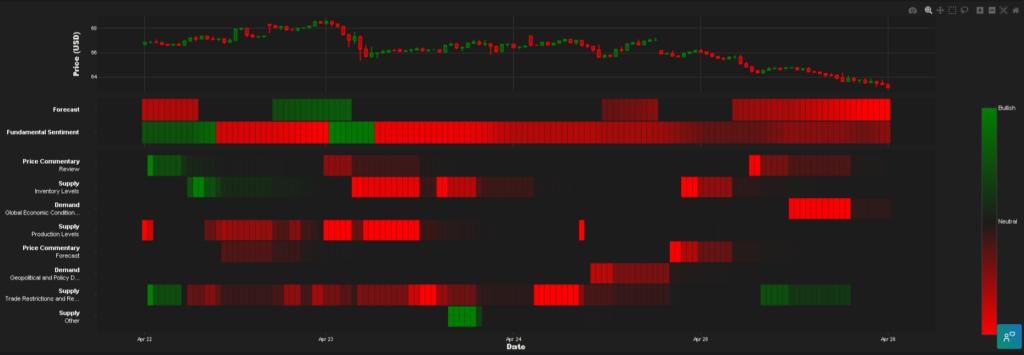*This article provides professional traders, institutional investors and financial analysts with an in-depth analysis of the euro’s recent appreciation against the dollar amid global trade tensions and shifting monetary policy expectations.
In the volatile world of currency trading, the euro rising against the dollar has become one of the most significant market trends of 2025. Since Trump’s “Liberation Day” tariff announcements on April 2nd, the euro has gained an impressive 5.3% against the greenback, marking its largest two-month decline in over two decades. What actually is going on here? The currency shift reflects a fundamental reorientation of global investor sentiment, with profound implications for both economies. In this article, we’ll explore the key drivers behind the euro rising against the dollar, with insights taken from our Trading Co-Pilot terminal.
Trade tensions driving currency movements
We’re now all well versed in the fact that the crisis in US-China trade relations has spilled over into broader global markets. Trump’s sweeping tariffs, including a 25% levy on all foreign-made cars and a 10% universal tariff, have sparked concerns about global trade tensions and their economic impact. All of which suggests investors are seeking safer havens for their capital, increasingly viewing Europe as more stable than the US in the current climate.
ECB President Christine Lagarde stated that tariffs imposed by Trump are likely to slow growth in the eurozone. Despite this, inflation in the euro area is expected to hover around the 2% target. The keys to understanding the euro rising against the dollar lie in how markets are interpreting these divergent economic signals.
Shifting monetary policy expectations
With many betting on significant interest rate cuts by the Federal Reserve, and expectations for five more cuts throughout 2025, the shift in monetary policy expectations has been a major driver behind the euro rising against the dollar.
Again and again, data releases have reinforced these expectations. US consumer confidence has dropped to its lowest level in five years, driven by concerns over tariffs. In addition, US economic output likely experienced its worst quarter since the onset of Covid, with growth occurring at the weakest rate in nearly three years.
We can be reasonably confident that these economic indicators are prompting the Federal Reserve to consider more aggressive rate cuts than previously anticipated. At least this is what market pricing suggests, with traders increasingly positioning for a more dovish Fed.
European economic resilience
Just as notably, despite a generally gloomy global economic outlook, Germany’s corporate sector exhibits a sense of optimism. This resilience in Europe’s largest economy is contributing to the euro rising against the dollar as investors reassess regional economic strength.
The present outlook for the Eurozone shows some surprising bright spots. What about bank lending? Eurozone loans to the private sector have increased at a faster pace, with ECB data indicating continued growth in bank lending prior to tariffs. ECB’s Kazaks expressed optimism about potential step-by-step rate cuts, while maintaining a cautious approach.
This age old method applies to understanding currency markets right now: follow the money. Investor capital is flowing toward European assets, boosting the euro rising against the dollar as markets digest the changing economic landscape.

Above: The above sentiment heatmap from our Trading Co-Pilot displays increasingly negative sentiment drivers for the US dollar (shown in red) across multiple economic factors from April 22-29, 2025, particularly in fundamental sentiment and trade policy areas, visually explaining the EUR/USD price decline from 67 to 63 as the euro strengthens against a weakening dollar.
Rebalancing European economics
If experience tells us anything it’s that currency shifts of this kind have significant economic implications. The fall in yields and appreciation of the euro is a tailwind for the eurozone’s domestic economy. For export producers, however, the euro strength is a headwind.
You can make the argument that if the current trend continues, it could accelerate the eurozone’s rebalancing away from external demand towards domestic demand. The hardest part is managing this transition without disrupting economic growth.
Increasingly, European policymakers will be viewing the current complex as an opportunity rather than a challenge. That said, the truth is more complicated than simple currency appreciation. As the euro rising against the dollar changes trade dynamics, it also helps for reducing import costs, particularly energy, which benefits European consumers and businesses.
Global trade reconfiguration
As we are already becoming accustomed to, we live in an age of highly volatile geopolitics. The US-China trade war is impacting global markets, with reports of the US merchandise trade deficit reaching a record high of $162 billion in March. There are several areas where this is creating ripple effects across the global economy.
What is needed is a clear understanding of how these trade tensions are reshaping global commerce. However, as long as we rely on traditional frameworks for understanding trade relationships, we may miss the fundamental restructuring taking place.
And we must acknowledge that China’s decision to reduce the 125% tariff on a major US export following predictions from the White House suggests Beijing may be seeking to de-escalate tensions. This is not to say that trade relations will normalise any time soon, but it perhaps indicates some flexibility if we are to be optimistic.
Market outlook and investment implications
We can expect continued volatility in currency markets as these trade and monetary policy dynamics play out. The question is whether the euro rising against the dollar represents a temporary adjustment or a more fundamental shift in currency valuations.
As for investment implications, this currency trend has significant consequences for multinational corporations and investors with exposure to both regions. Defining what is classed as appropriate currency hedging strategies becomes increasingly important in this environment.
Last but not least, it’s worth considering the psychological aspects of market movements and sentiment. If narratives shape politics, they also shape markets, and the narrative around the euro rising against the dollar has gained considerable momentum.
While it’s true that currency markets can reverse quickly, the underlying factors driving the euro rising against the dollar suggest this trend may have staying power as long as the fundamental drivers remain in place. To reclaim strength in this area, the dollar would need either a shift in US trade policy or more hawkish Fed positioning than markets currently expect.
Stay ahead of currency market movements
To gain deeper insights into these currency trends and make more informed trading decisions, access our comprehensive market analysis through the Trading Co-Pilot terminal or API. Our real-time sentiment analysis and expert commentary provide the edge you need in today’s volatile market conditions. Contact our team at enquiries@permutable.ai today to unlock premium currency insights that go beyond traditional market data or fill in the form to request a demo.
